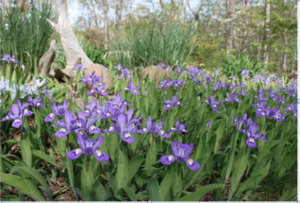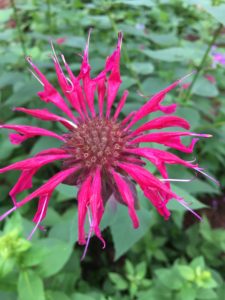I love wildflowers. They make me happy just to look at them. Therefore, it’s not surprising that I have planted a multitude of wildflowers right outside my back door. But what, really did I plant? Are these plants wild? naturalized? indigenous? Are they weeds? There’s a lot of terminology and it can be pretty confusing. F or general purposes, I consider a native plant to be a plant that grows in a place where it first evolved.
or general purposes, I consider a native plant to be a plant that grows in a place where it first evolved.
You could argue, of course, that my back yard is not the “place” where these plants evolved and you’d be absolutely right. But evolving “in the neighborhood” is close enough for me. There are purists in the gardening world who only grow plants indigenous to a specific region. I applaud their ambitions but I’m more casual and eclectic in my choice of flowers and my landscape is a blend of native Southern plants and cultivated varieties from all over the world. Solomon Seal arches over Siberian iris. Bee balm blooms side by side with English roses and summer phlox makes pink exclamation points against a bank of Asiatic lilies.
My first priority is the beauty of the garden. But beauty is only one  reason (though, in my opinion, the best!) to grow native plants. Other reasons?
reason (though, in my opinion, the best!) to grow native plants. Other reasons?
- They are already adapted to your growing region
- They attract native pollinators
- They help preserve the natural ecology of an area
Just because a plant is native to your region does not mean that it will thrive anywhere you put it, though. You still have to know what a plant likes (sun? shade? rich, well drained soils? lots of moisture?) to be able to give it the conditions it needs.
There are generalizations that can be made. For the most part, woodland wildflowers bloom in spring and like slightly acidic, well drained soils that are rich in organic matter. Most woodland spring flowers are low growing, small and delicate and include beauties such
in spring and like slightly acidic, well drained soils that are rich in organic matter. Most woodland spring flowers are low growing, small and delicate and include beauties such
 as bloodroot, trillium, green and gold, woodland phlox, dwarf crested iris, Solomon’s Seal. Ferns and shrubs such as native azaleas (deciduous), mountain Laurels and oak leaf hydrangeas should also be a part of a woodland spring garden.
as bloodroot, trillium, green and gold, woodland phlox, dwarf crested iris, Solomon’s Seal. Ferns and shrubs such as native azaleas (deciduous), mountain Laurels and oak leaf hydrangeas should also be a part of a woodland spring garden.
 Sun loving natives, in general, bloom in Summer. They are hardier, bigger and more exuberant than their ephemeral spring cousins and will thrive and bloom in soils that are drier and not as rich as woodland soils. These include bee balm, purple coneflowers, black eyed Susans, summer phlox and calendula. Fall wildflowers need similar conditions and include goldenrods and asters.
Sun loving natives, in general, bloom in Summer. They are hardier, bigger and more exuberant than their ephemeral spring cousins and will thrive and bloom in soils that are drier and not as rich as woodland soils. These include bee balm, purple coneflowers, black eyed Susans, summer phlox and calendula. Fall wildflowers need similar conditions and include goldenrods and asters.
Growing native plants is really just like growing any other kind of plant, just more fun! (My personal opinion!) All of the natives mentioned here are perennials, saving you the time, money and effort it takes to buy and plant annuals every year. So, give them a little TLC when they’re babies, help them get established and put down some good roots and they will repay you with years of color, beauty and joy.


For Kids!
Summer blooming wildflowers are usually abundant enough to pick and do something with. Here are a few ideas:
- Pick some flowers, leaves, and even roots to make your own fantastic creatures. Just glue them items to a piece of paper, using petals for a skirt, leaves for arms, roots for hair, etc.
- Use brightly colored petals and rub them on white paper to make colored marks. You can use yellow petals to make a sun, blue petals to make a sky, real dirt to make dirt and lots of green petals to make trees or grass or whatever.
- Pick a handful of beautiful flowers with long stems. Bring them in and put them in a jar of water, cutting the stems until they are the right length. If you don’t have enough flowers to fill the mouth of the jar and your flowers flop to one side, pick small branches or vines or something to fill in the sides. Have fun.

I love hearing about your passion for wildflowers! Have you ever just wanted to jump in and roll around in them?
Ha! All the time!
Your blog is really cool you should write about birds
Thanks. I’ll write about birds soon. Maybe cardinals and chickadees?
Would like very much to talk to you about our place before we do anything rash. Would you be willing to consult?